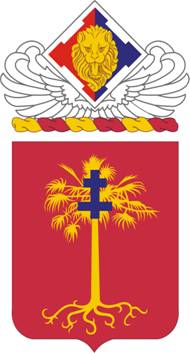Related Research Articles

Artillery are ranged weapons that launch munitions far beyond the range and power of infantry firearms. Early artillery development focused on the ability to breach defensive walls and fortifications during sieges, and led to heavy, fairly immobile siege engines. As technology improved, lighter, more mobile field artillery cannons developed for battlefield use. This development continues today; modern self-propelled artillery vehicles are highly mobile weapons of great versatility generally providing the largest share of an army's total firepower.

The 101st Airborne Division (Air Assault) ("Screaming Eagles") is a light infantry division of the United States Army that specializes in air assault operations. It can plan, coordinate, and execute multiple battalion-size air assault operations to seize terrain. These operations can be conducted by mobile teams covering large distances, fighting behind enemy lines, and working in austere environments with limited or degraded infrastructure. It was active in, for example, foreign internal defense and counterterrorism operations in Iraq, in Afghanistan in 2015–2016, and in Syria, as part of Operation Inherent Resolve in 2018–2021.
A division is a large military unit or formation, usually consisting of between 6,000 and 25,000 soldiers. In most armies, a division is composed of several regiments or brigades; in turn, several divisions typically make up a corps.

A regiment is a military unit. Its role and size varies markedly, depending on the country, service, or specialisation.

A brigade is a major tactical military formation that typically comprises three to six battalions plus supporting elements. It is roughly equivalent to an enlarged or reinforced regiment. Two or more brigades may constitute a division.

The 14th Armored Division was an armored division of the United States Army assigned to the Seventh Army of the Sixth Army Group during World War II. It remains on the permanent roll of the Regular Army as an inactive division, and is eligible for reactivation. The division is officially nicknamed the "Liberators".

The 40th Infantry Division is a modular division of the United States Army. Following the army's modularization the division has become a four-brigade combat team with National Guardsmen from throughout the Pacific/Western United States and Oceania. Its division headquarters is located at Los Alamitos Joint Forces Training Base in Los Alamitos, California.

The 35th Infantry Division, formerly known as the 35th Division, is an infantry formation of the United States Army National Guard headquartered at Fort Leavenworth, Kansas.

The 80th Training Command is a formation of the United States Army Reserve.

The 90th Infantry Division was a unit of the United States Army that served in World War I and World War II. Its lineage is carried on by the 90th Sustainment Brigade.

The 92nd Infantry Division was an African-American, later mixed, infantry division of the United States Army that served in World War I, World War II, and the Korean War. The military was racially segregated during the World Wars. The division was organized in October 1917, after the U.S. entry into World War I, at Camp Funston, Kansas, with African-American soldiers from all states. In 1918, before leaving for France, the American buffalo was selected as the divisional insignia due to the "Buffalo Soldiers" nickname, given to African-American cavalrymen in the 19th century. The divisional nickname, "Buffalo Soldiers Division", was inherited from the 366th Infantry, one of the first units organized in the division.

The 33rd Infantry Division was a formation of the U.S. Army National Guard between 1917 and 1968. Originally formed for service during World War I, the division fought along the Western Front during the Battle of Amiens, the Battle of Hamel, the Meuse-Argonne Offensive, at the Second Battle of the Somme, and at the Battle of Saint-Mihiel. It was re-formed during the inter-war period, and then later activated for service during World War II, seeing action against the Imperial Japanese Army in the Pacific. In the post war era, the division was reconstituted as an all-Illinois National Guard division. In the late 1960s, the division was reduced to a brigade-sized formation, and its lineage is currently perpetuated by the 33rd Infantry Brigade Combat Team.

The 27th Infantry Division was a unit of the Army National Guard in World War I and World War II. The division traces its history from the New York Division, formed originally in 1908. The 6th Division designation was changed to the 27th Division in July 1917.

Field artillery in the American Civil War refers to the artillery weapons, equipment, and practices used by the Artillery branch to support the infantry and cavalry forces in the field. It does not include siege artillery, use of artillery in fixed fortifications, or coastal or naval artillery. Nor does it include smaller, specialized artillery classified as small arms.

The 39th Infantry Division was an infantry formation of the Army National Guard, originally formed as the 18th Division in 1917. The division consisted of troops from Arkansas, Louisiana, and Mississippi. After training at Camp Beauregard, Louisiana, the division was deployed to France but did not see combat before the end of World War I. In July 1923 the division was re-designated as the 31st Infantry Division. The 39th Infantry Division was reactivated after World War II with troops from Louisiana and Arkansas and its headquarters in Louisiana. In 1967, the 39th Infantry Division was reorganized to become the 39th Infantry Brigade (Separate). Its headquarters was in Little Rock and the unit consisted entirely of troops from Arkansas.

The 320th Field Artillery Regiment is a field artillery regiment of the United States Army. A parent regiment under the U.S. Army Regimental System, the 320th FAR currently has two active elements in the 101st Airborne Division : 1st Battalion, 320th FAR "Top Guns" in 2nd Brigade Combat Team; and 3rd Battalion, 320th FAR "Red Knight Rakkasans" in 3rd Brigade Combat Team. The regiment served with the 82nd Airborne Division during World Wars I and II, and regimental elements have served with the 82nd and 101st Airborne Division, the 193rd Infantry Brigade and the Berlin Brigade, and conducted combat operations in the Dominican Republic, Vietnam, Grenada, Operations Desert Shield and Storm, and the Global War on Terror.
The 275th Rifle Division was an infantry division of the Soviet Union's Red Army during World War II, formed twice.
The 122nd Field Artillery Regiment is a field artillery regiment of the Illinois Army National Guard. The regiment's 2nd Battalion is the cannon battalion assigned to the 33rd Infantry Brigade Combat Team.
The 391st Rifle Division was raised in 1941 as an infantry division of the Red Army, and fought the German Operation Barbarossa. It began forming in August 1941, in the Central Asian Military District. It was first assigned to Southwestern Front but on its arrival it was seen to be far from combat-ready and so was moved north to the Moscow area for further training. It was finally assigned to the 3rd Shock Army in Kalinin Front and took part in the battle for the Kholm Pocket. Following this the division was moved to 1st Shock Army and took part in the dismal fighting for the Demyansk salient until it was finally evacuated by the German forces in March, 1943. The division moved on into the gradual advance across the Baltic states through 1943 and 1944, winning a battle honor along the way, until February, 1945, when it was transferred with its 93rd Rifle Corps to 1st Ukrainian Front as part of 59th Army. In the last weeks of the war the 391st was awarded the Order of the Red Banner for its service in Upper Silesia, and ended the war advancing on Prague, but despite its distinguished record it was selected as one of the many divisions to be disbanded during the summer of 1945.
The 237th Rifle Division was an infantry division of the Red Army, originally formed in the months just before the start of the German invasion, based on the shtat of September 13, 1939. At the opening of Operation Barbarossa it was in the Leningrad Military District where it had formed near the Finnish border but was soon moved south to defend against German Army Group North. As part of 16th Rifle Corps in 11th Army it took part in the battle of Soltsy, which imposed a significant delay on the German advance toward Leningrad. In August it was encircled while serving with 48th Army and suffered such heavy losses that it was disbanded on September 17.
References
- ↑ Farrow, Edward Samuel (1918). A Dictionary of Military Terms. Thomas Y. Cromwell Co. pp. 20.
- ↑ Loomis, Ernest (1920). History of the 304th Ammunition Train. R.G. Badger. pp. 15.